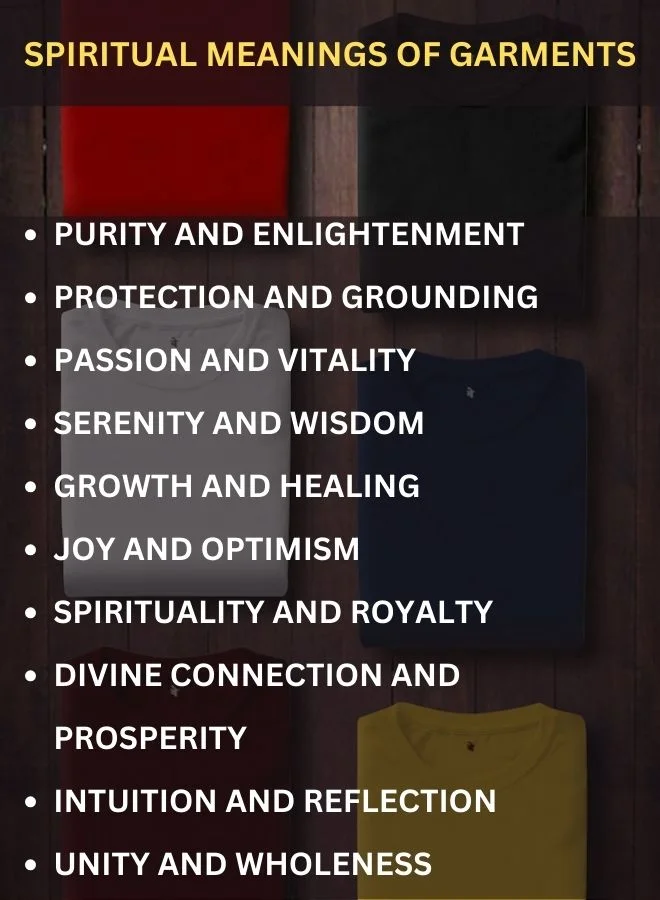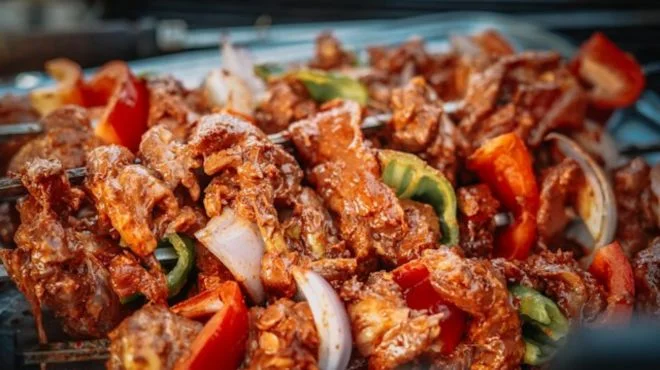Garments hold symbolic meanings: white for purity, black for protection, red for passion, blue for wisdom, green for healing, yellow for joy, purple for spirituality, gold for prosperity, silver for intuition, and a rainbow for unity.
In a world brimming with fashion trends and style statements, there exists a realm beyond mere aesthetics—a realm where clothing transcends its material form to embody spiritual significance and symbolism. Welcome to the enchanting world of spiritual garments, where each thread tells a tale of deeper meaning and cultural heritage.
Spiritual Meanings of Garments

White Garments: Purity and Enlightenment
White garments symbolize purity, innocence, and spiritual enlightenment across various cultures. When wearing white robes, individuals may feel a sense of cleansing for the soul, representing a pursuit of higher truths and spiritual growth.
White serves as a canvas for inner reflection and the embodiment of divine light, guiding individuals on a path towards purity and enlightenment.
Black Garments: Protection and Grounding
Despite their association with darkness, black garments symbolize protection, grounding, and connection to the earth. Wearing black serves as a shield against negative energies, distractions, and external influences.
It offers a sense of stability and security, allowing individuals to remain grounded amidst life’s challenges and uncertainties, fostering inner strength and resilience.
Red Garments: Passion and Vitality
Red garments exude feelings of passion, vitality, and life force energy. The fiery hue ignites creativity, enthusiasm, and determination, fueling individuals’ pursuits with vigor and zeal.
Wearing red symbolizes a zest for life and a willingness to embrace passion in all its forms, empowering individuals to pursue their dreams and ambitions with unwavering intensity.
Blue Garments: Serenity and Wisdom
Blue garments embody the tranquil depths of the ocean and the vast expanse of the sky, evoking feelings of serenity, calmness, and wisdom. Wearing blue instills a sense of clarity and inner peace, guiding individuals on a journey of self-discovery and enlightenment.
It encourages introspection and contemplation, fostering a deeper understanding of oneself and the world around them.
Green Garments: Growth and Healing
Green garments, reminiscent of lush foliage, symbolize growth, renewal, and healing. Wearing green nurtures the spirit, fostering personal development and transformation. It represents the cycle of life and the interconnectedness of all living beings, offering solace and rejuvenation in times of struggle or adversity.
Yellow Garments: Joy and Optimism
The radiant glow of yellow garments mirrors the warmth of the sun, infusing life with joy, optimism, and positivity. Wearing yellow uplifts the spirits, dispelling negativity and filling individuals’ hearts with happiness and cheerfulness.
It symbolizes the endless possibilities of life and the inherent brightness of the human spirit, encouraging individuals to embrace optimism and spread joy wherever they go.
Purple Garments: Spirituality and Royalty
Purple, long associated with royalty and spiritual enlightenment, embodies regal grace and inner sovereignty. Wearing purple garments signifies a deep connection to the divine and a reverence for spiritual truths.
It empowers individuals to embrace their innate nobility and embrace their spiritual journey with dignity and purpose.
Gold Garments: Divine Connection and Prosperity
The shimmering allure of gold garments reflects the divine light within, symbolizing abundance, prosperity, and spiritual wealth. Wearing gold deepens individuals’ connection to the divine, attracting blessings of abundance and prosperity into their lives.
It serves as a reminder of the inherent value and worthiness of each individual, guiding them towards fulfillment and spiritual fulfillment.
Silver Garments: Intuition and Reflection
Silver garments, reminiscent of the moon’s gentle glow, invite introspection, intuition, and inner reflection. Wearing silver awakens psychic abilities and enhances spiritual awareness, guiding individuals on a journey of self-discovery and enlightenment.
It symbolizes the interconnectedness of the universe and the power of intuition in navigating life’s mysteries and uncertainties.
Rainbow Garments: Unity and Wholeness
The vibrant spectrum of rainbow garments celebrates diversity, unity, and wholeness. Wearing rainbow attire fosters a sense of inclusivity and belonging, honoring the beauty of individuality and the interconnectedness of all living beings.
It serves as a reminder of the inherent unity that binds humanity together, inspiring individuals to embrace diversity and cultivate harmony in their lives and communities.
Variations and Spiritual Meanings of Garments
Traditional Clothing from Different Cultures
Indian Sari: Symbol of Grace and Femininity (Hinduism)
The Indian sari is more than just clothing; it’s a symbol of grace, femininity, and cultural heritage deeply rooted in Hinduism. Each drape, fold, and pleat tells a story of tradition, spirituality, and timeless beauty.
The intricate patterns and vibrant colors of the sari reflect the diverse culture and rich history of India, making it a revered garment for women across generations.
Japanese Kimono: Emblem of Tradition and Elegance
The Japanese kimono is a masterpiece of exquisite craftsmanship, embodying tradition, nature, and aesthetic harmony. Wearing a kimono is akin to stepping into a timeless work of art, with every stitch and pattern reflecting Japan’s rich cultural heritage.
Its graceful silhouette and elegant design evoke a sense of grace, dignity, and cultural pride, making it a revered symbol of Japanese identity and tradition.
Native American Regalia: Representation of Heritage and Spirituality
Native American regalia is not merely clothing; it’s a representation of heritage, spirituality, and tribal identity. The intricate beadwork, vibrant colors, and symbolic motifs woven into each garment carry the prayers and traditions of generations past.
From the feathers adorning headdresses to the intricate patterns embellishing dresses, regalia serves as a tangible link to Native American culture, honoring the earth and its inhabitants with reverence and respect.
Tibetan Robes: Manifestation of Devotion and Asceticism
Tibetan robes may appear humble in their simplicity, but they embody profound devotion to spiritual practice and asceticism. Wearing Tibetan robes is a testament to the impermanence of material possessions and the importance of cultivating inner wealth and compassion.
Each robe is a reminder to practitioners of their commitment to the path of enlightenment, embodying humility, simplicity, and a deep reverence for spiritual teachings.
African Dashiki: Expression of Identity and Community
The bold patterns and vibrant colors of the African dashiki are more than just clothing; they’re a powerful expression of identity, community, and cultural resilience. Wearing a dashiki is a statement of pride, solidarity, and connection to African heritage.
Its intricate designs and symbolic motifs celebrate the rich tapestry of African culture, history, and tradition, honoring the spirit of unity and resilience that defines the African diaspora.
Arabian Thobe: Symbol of Modesty and Dignity
The flowing elegance of the Arabian thobe embodies the values of modesty, dignity, and respect deeply ingrained in Arab culture. Wearing a thobe is like wrapping oneself in a cloak of honor and tradition, honoring the timeless principles of humility and grace.
Its simple yet sophisticated design reflects the enduring beauty and cultural significance of traditional Arab attire, symbolizing reverence for tradition and a deep sense of pride in one’s heritage.
Scottish Kilt: Reflection of Honor and Pride
The Scottish kilt is more than just a garment; it’s a reflection of honor, pride, and the rugged spirit of Scotland. Wearing a kilt is a badge of honor, symbolizing resilience, strength, and a deep connection to Scottish heritage and homeland.
Its distinctive tartan patterns and traditional design evoke a sense of history and tradition, celebrating the rich cultural legacy of Scotland and its people.
Mexican Huipil: Commemoration of Ancestral Wisdom and Craftsmanship
The Mexican huipil is a testament to the artistic legacy and cultural heritage of indigenous communities in Mexico. Its intricate embroidery, vibrant colors, and symbolic motifs pay homage to ancestral wisdom and craftsmanship, honoring the creativity, resilience, and ingenuity of generations past.
Wearing a huipil is like wearing a piece of history, celebrating the rich cultural tapestry of Mexico and its indigenous roots.
Greek Chiton: Tribute to Classical Beauty and Artistry
The Greek chiton embodies the timeless ideals of beauty, grace, and artistry that define classical Greek civilization. Its flowing silhouette and elegant draping evoke the mythical tales of ancient gods and goddesses, channeling the spirit of Greek mythology and legend.
Wearing a chiton is like stepping into a living piece of history, honoring the legacy of Greek civilization and its enduring influence on art, culture, and civilization.
Chinese Hanfu: Emblem of Cultural Revival and Harmony
The Chinese hanfu symbolizes a revival of traditional culture and a celebration of harmony and balance deeply rooted in Chinese civilization. Its flowing silks, intricate designs, and elegant craftsmanship embody the timeless beauty and grace of Chinese tradition, reflecting a harmonious balance between nature, humanity, and the cosmos.
Wearing hanfu is like stepping into a living painting, honoring the rich cultural heritage of China and its enduring legacy of artistic expression and refinement.
Biblical and Hindu Meanings of Garments

Biblical References
Garments of Righteousness: Clothed in Virtue and Grace
In biblical symbolism, garments of righteousness represent the virtues of purity, integrity, and moral uprightness. Donning these spiritual garments is a reminder to walk in the path of righteousness and live a life worthy of divine favor.
The Armor of God: Equipped for Spiritual Warfare (Ephesians 6:11)
The metaphorical armor described in Ephesians 6:11 serves as protection against spiritual battles and unseen forces of darkness. Each piece of spiritual armor, from the breastplate of righteousness to the sword of the Spirit, empowers believers to stand firm in their faith and overcome adversity.
The Robe of Salvation: Redemption and Renewal (Isaiah 61:10)
Isaiah 61:10 speaks of putting on the robe of salvation as a symbol of divine redemption and renewal. This spiritual garment signifies a new beginning, a fresh start, and a restored relationship with the divine.
The Garment of Praise: Joyful Expression and Worship (Isaiah 61:3)
Isaiah 61:3 invites believers to exchange their spirit of heaviness for a garment of praise, symbolizing joyful expression and worship. This spiritual attire uplifts the soul and invites divine presence into every aspect of life.
The Wedding Garment: Preparedness for the Divine Union (Matthew 22:11-14)
In the parable of the wedding feast (Matthew 22:11-14), the wedding garment represents preparedness and readiness for the divine union with the bridegroom, symbolizing spiritual purity and devotion.
Hinduism Perspectives
Sacred Thread (Yajnopavita): Symbol of Initiation and Spiritual Connection
In Hindu tradition, the sacred thread ceremony marks the initiation of young boys into spiritual learning and signifies their connection to the divine and their ancestors.
Vastram: Offering of Clothing to Deities and Saints
The offering of clothing, known as vastram, is a common practice in Hindu worship, symbolizing devotion, humility, and gratitude to the divine.
Saffron Robes (Bhiksha Vastra): Sign of Renunciation and Detachment
Saffron robes, worn by ascetics and renunciates, symbolize detachment from worldly desires and a commitment to the pursuit of spiritual truth and enlightenment.
Mundu and Veshti: Traditional Clothing for Rituals and Ceremonies
The mundu and veshti, traditional garments worn in South India, are often donned during religious rituals and ceremonies, symbolizing reverence and respect for tradition and culture.
Silken Garments: Associated with Prosperity and Auspiciousness
Silken garments hold special significance in Hindu culture, symbolizing prosperity, auspiciousness, and divine blessings. They are often worn during festive occasions and religious ceremonies as a symbol of abundance and good fortune.
Cultural Significance of Garments
In addition to their spiritual meanings, garments hold significant cultural importance in societies around the world.
Social Status and Identity
Clothing has long been used as a marker of social status, wealth, and identity. From the ornate robes of royalty to the humble attire of commoners, garments reflect societal hierarchies and cultural norms.
Rites of Passage and Ceremonial Attire
Many cultures mark important life milestones and rites of passage with special ceremonial attire. Whether it’s a wedding gown, a graduation robe, or a religious vestment, these garments symbolize transition, transformation, and growth.
Expression of Beliefs and Values
Garments often serve as a canvas for expressing one’s beliefs, values, and cultural heritage. Whether it’s religious attire, cultural dress, or fashion statements, clothing communicates a message about who we are and what we stand for.
Artistic and Craftsmanship Traditions
The creation of garments is an art form that spans cultures and centuries. From intricate embroidery to handwoven textiles, garments showcase the skill and creativity of artisans around the world, preserving cultural traditions and craftsmanship for future generations.
Gender Roles and Power Dynamics
Clothing has historically been used to reinforce gender roles and power dynamics within society. Whether through modest attire for women or elaborate uniforms for military and political leaders, garments can shape perceptions of identity, authority, and social roles.
Enhancing Spiritual Life through Garments
Beyond their cultural and symbolic significance, spiritual garments offer a pathway to deeper spiritual connection and personal growth.
Mindful Dressing
By approaching clothing choices with mindfulness and intentionality, individuals can align their outer appearance with their inner values and spiritual aspirations. Whether it’s wearing colors that uplift the spirit or selecting garments made from sustainable and ethically sourced materials, mindful dressing can be a powerful tool for cultivating spiritual awareness and harmony.
Rituals and Blessings
Through rituals and blessings, individuals can imbue their garments with positive energy and intentions, transforming them into sacred objects that carry the power of prayer and intention.
Whether it’s blessing new clothing before wearing it or performing rituals to cleanse and purify garments, these practices can deepen one’s spiritual connection to clothing and enhance their efficacy as tools for spiritual growth and protection.
Symbolic Adornments
In addition to clothing, accessories such as jewelry, scarves, and amulets can also hold spiritual significance and symbolism.
Whether it’s wearing a pendant engraved with a meaningful symbol or adorning oneself with crystals believed to have healing properties, these symbolic adornments can serve as reminders of one’s spiritual path and intentions, amplifying their energetic resonance and spiritual efficacy.
Community Practices
Participating in group ceremonies and festivals centered around clothing and adornment can foster a sense of community and shared spiritual connection.
Whether it’s attending religious ceremonies where special garments are worn or joining cultural celebrations that feature traditional attire and rituals, these communal practices can deepen one’s sense of belonging and spiritual kinship with others.
Inner Reflection
Ultimately, the journey of spiritual fashion is not just about outward appearances but about inner transformation and self-discovery.
By reflecting on the symbolism and significance of their clothing choices, individuals can gain insights into their beliefs, values, and aspirations, using garments as mirrors for their spiritual journey and catalysts for personal growth and evolution.
Conclusion
In the tapestry of human experience, clothing occupies a sacred space where the material and the spiritual converge. From the ancient rituals of indigenous cultures to the modern expressions of global fashion, garments have always served as vessels for meaning, identity, and connection.
As we navigate the intricate threads of our spiritual journey, may we remember the profound significance of the garments we wear and the stories they tell—the stories of who we are, where we come from, and the divine spark that resides within us all.
So, let us embrace the transformative power of spiritual fashion and embark on a journey of self-discovery, connection, and soulful expression—one garment at a time.







